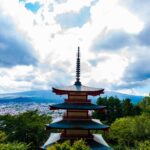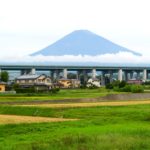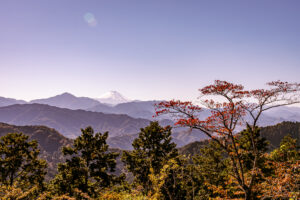It seemed almost criminal to leave Tokyo at the peak of autumn. There was colour everywhere, the trees lining the path with the leaves slowly changing shades, bright yellow at one place to a luminescent red at another, even the ones which have been shed and lined the sides of the path shone brightly.The days were crisp and bright and a chill permeated the air.
But there was a duty to fulfil, a travel that could not be delayed any longer and with promising signs of calm across the skies. Air India, now owned by the Tatas restarted it’s Tokyo-Delhi flight.
It is probably too early to expect any changes in the service levels at Air India, their web site rejected most of my credit cards and when it finally accepted one it led to a hung screen and no indication whether the ticket had been booked.
It took a few more hours for the ticket to arrive and another few to confirm which credit card it was booked on. The Airlines in India require you to carry the credit card used in the booking, hence the need to know the exact card used.
Travel during the pandemic comes with preconditions. A RT-PCR test is required within 72 hours of travel, contact details need to be filled in and uploaded, forms absolving the airline of all responsibility , downloaded and signed.
An internet search revealed a clinic near Kabukicho that did a test at a reasonable price. An appointment was made and reconfirmed and the clinic, placed in the basement of a popular hotel located.
The reception staff looked at my passport and wished me a Happy Birthday copied my passport and pointed to the room I was supposed to wait. A probing swab was pushed into the recesses of my nasal passages by an apologetic nurse and my test was done.
A few hours later I had my negative result over email along with a certificate and I was ready to travel! The certificate was printed, the online form reconfirmed and a few rounds of checks on the travel conditions done.
In pre-pandemic days I would take a cab to a bus stop around 2 kms from my house, and take a bus to the airport. I realised that the bus company had stopped all services and the alternative was changing three trains , so I decided to take a cab instead.
When my cab approached the final stretch to the airport and slowed down to negotiate the curving road, a fence on the right separating it from the runway I heard the roar of an aircraft engine and looking out of the window saw it descend, the carriage extended to land.
There have been days when I stand by the edge of the bay near my house and watch aircraft land at the Haneda airport. The airport is at a distance and I can watch the aircraft make the final descent and then disappear from view. In the pandemic days I have stood there for long periods , counted and tried to identify the planes, trying to understand which ones are coming from overseas and hoped that the increasing numbers would continue and I would be back at the airport catching my next flight.
The year 2021 began in hope, the vaccines were supposed to drive away the virus and travel start again, but the effectiveness of the vaccines, the irrational attitude of the deniers and irresponsibility by both people and nations have smothered any attempts at revival. So the dream of being back at an airport has remained just that, a dream, until today.
When you have been deprived of something for long, a faint whiff or a fleeting sight of what you have been deprived is enough to trigger the desire for what you have missed. An aircraft flying close overhead was my trigger. There was this tingling euphoria which seemed to push against the pores , giddiness in the chest and palpitations of excitement.
The euphoria collapsed when I arrived at a deserted Narita Airport. I knew that Japan had not opened up international travel, it was still restricted to those who really needed to travel, but a deserted airport, at least an almost deserted airport was not what I had in mind.
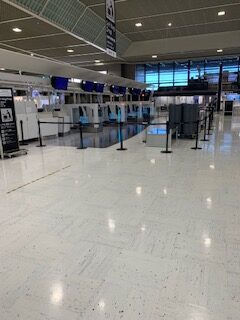
There were 2 people standing at a bus counter, a skeleton fleet still ran at fixed intervals and there were probably 5 travellers outside. When I entered I found only the Air India and FinnAir counters open and there were less than 20 people lined up between the two.
The only shop that was open was a drugstore and a foreign exchange counter. A SECOM robot patrolled the premises noisily and only a handful of staff were visible.

The check-in process involved the staff confirming the printed out forms, the RT-PCR test report and whether I had filled in an online declaration.
Security and immigration have always been efficient at both the Tokyo airports, the lack of passengers means things happened even faster and smoother. I had to be reminded by the immigration officer to remove my mask and I was inside the deserted departure area.
Shops, restaurants and everything else between them were closed and the only signs of life were near the Air India departure gates. Passengers conscious at maintaining social distance ensured there was no crowding at the gates.
As I waited for the plane, an alert flashed on my phone, a new mutated variant of virus being discovered in South Africa . The last two years have taught that hope is futile and fear unproductive. The expectations of the vaccine goes hand in hand with the resignation at the effectiveness of vaccination process.
Hope may be futile but so is despair. An acceptance of whatever might come is the only path to sanity in the midst of uncertainty. The hopelessness of hope is not greater than dread of despair.
Japan had started easing travel restrictions, the quarantine period after arrival was being cut for those with proof of being fully vaccinated and there was an expectation that international flights would increase.
The idea that another mutation of the virus would bring it all to a stop was still unknown as I lined up to board the aircraft.
Boarding was called by seating rows, the staff handed over face shields, masks and disinfecting wipes, they showed my how to put on the face shield, a few stepsand I was in the aircraft.
I was stepping inside an aircraft after 23 months, a fact made clear when I searched for a socket for my headphones. It took me a few minutes to realise that the front of the armrest, the part not visible to the eye was where the headphone socket went in.
The 9 hour flight was uneventful, a face-shield was required over my mask and a few hours into the flight I tried to scratch my head and having no feeling from the scalp figured that it had gone numb. The tightly fitting face-shield had cut off circulation.
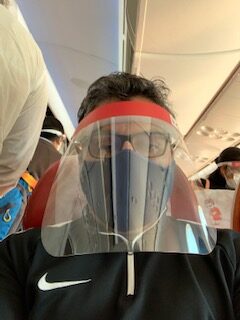
My Apple Watch reminded me to stand every hour and I took the opportunity to head to the toilet, take off my faces shield wait for sometime before heading back to my seat.
Social distancing was maintained on the flight, any empty seat was there between most passengers, the ones unlucky enough not have an empty seat next to them had to wear a protective coat.
Announcements went out asking passengers not to crowd around toilets and to wear masks and face shields at all times except while eating. The passengers were compliant and the crew did not have to remind the passengers.
The surprise was at arrival in the fact that there were no checks required, no questions asked about travel history, no random tests required. The immigration officers did not ask questions, the customs seemed disinterested , only a handful with a large quantity of luggage being questioned.
The baggage checked in for my connection flight, I went to wait for my flight in the domestic terminal. Regular announcements came on asking passengers to wear masks , maintain social distancing and yet the crowded domestic terminal seemed to have very few people following the regulations.
Most people had a mask on, but a large number of them had uncovered noses, many others had totally taken them off even after finishing eating and drinking. There was a disconnect between what was expected and what was being followed.

The casual disregard for laws is something that takes getting used to every time I travel back to India. Flouting rules is a badge of honour many want to wear, the fact that following the rules can possibly save lives seems irrelevant.
The memory of the recent devastation seems to have been erased. There seems to be an utter lack of will at prevention, a reactionary response is the expectation.
I have come to India after more than two years and yet nothing seems to have changed. The crowds at the airports might be marginally less that those in 2019, people might be wearing masks even if on the neck but the pandemic that recently devastated a majority of the country seems to be ignored.
Restrictions might not be the answer but precautions definitely are.
As I leave the Hyderabad airport, taking the cab to the hotel where I plan to stay for the next week, a gentle breeze blows the dust off the streets. As cars speed by, the late night hour reducing the traffic, the mask on the driver’s face slips and despite his attempts at pulling it up it stays down for most of the ride.
The destructive power of Omicron is not known yet, but as I lean back in my seat all I feel a sense of despair .


